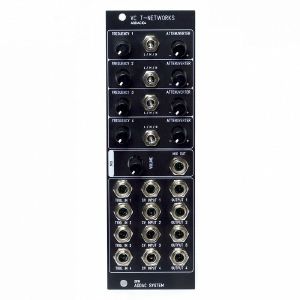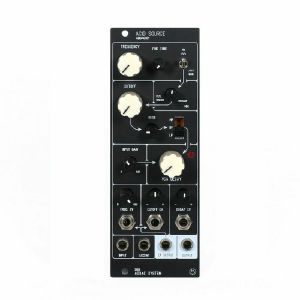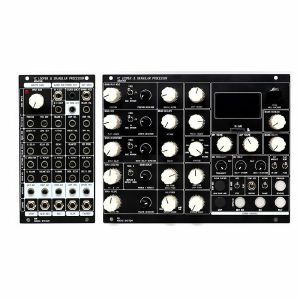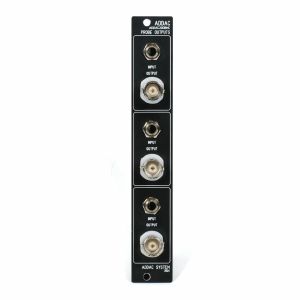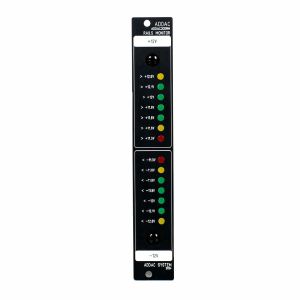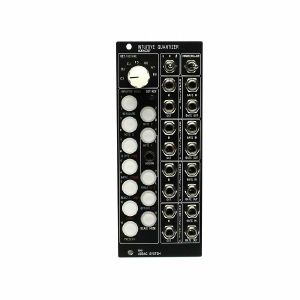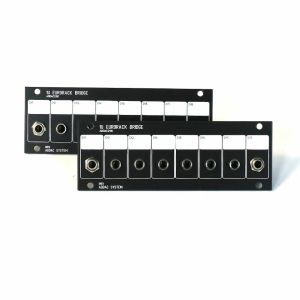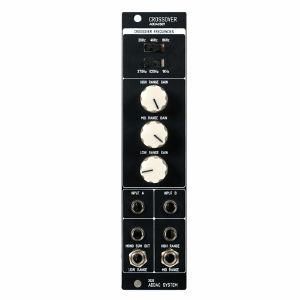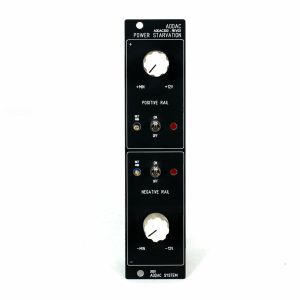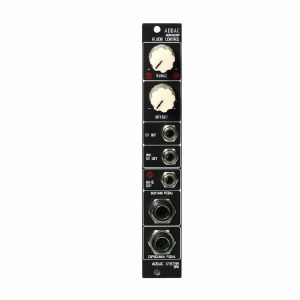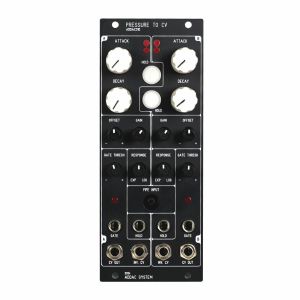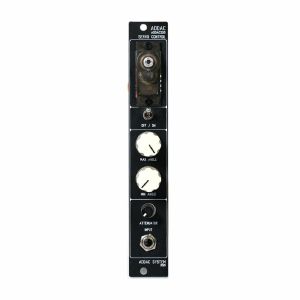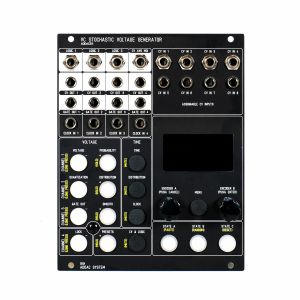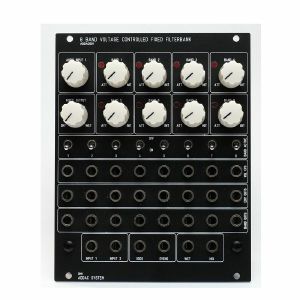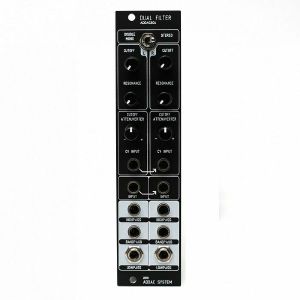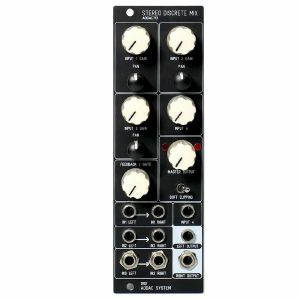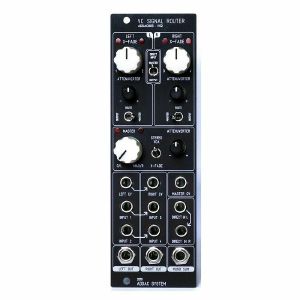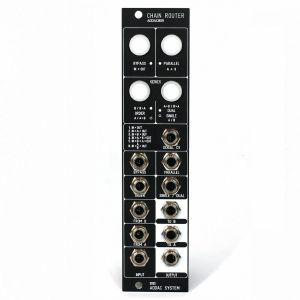Filter
Equipment
Format
Featured
Price
Tags
At each voice input there's a gate to trigger converter so any input source is possible.
Audio inputs can also be used as an input, in this case and due to the nature of the gate to trigger converter, each voice can be used as very destructive filters.
The top 2 channels feature a higher frequency range, the bottom 2 channels feature a lower frequency range.
2 in stock $174.92
quote 776116
A fresh twist on a simple 303-style acid synth, featuring a triangle/sawtooth/square wave VCO, multi-mode resonant filter, simple AD envelope and a VCA which can be overdriven. Excellent value.
Supplier's Notes:
ADDAC started this module with the idea of developing a complex drum source however, somewhere along the process, it was clear how much better it performed as a synth voice and this lucky accident was embraced.
It features a VCO with a [FREQUENCY] and [FINE TUNE] knob plus a dedicated CV Input and Attenuator knob (tunable over 4 octaves).
The VCO waveform output is achieved by selecting either a Triangle or Saw through a switch. the selected waveform can then be mixed/balanced against the square wave. The resulting mix is then sent to the Filter.
The Filter features a [CUTOFF] and [RESO] resonance knob plus a Cutoff CV Input and Attenuverter knob.
A 3 position switch is used to select the filter type: Highpass, Bandpass or Lowpass.
The resulting output is then sent to the VCA.
The VCA features an Input with [INPUT GAIN] knob which at maximum can amplify the incoming signal by a factor of 2.
This is a very important control, it accepts any signal Trigger, Gate or CV. Whatever input is plugged in the signal is then fed through an AD with a very short attack and controllable decay through the [VCA DECAY] knob plus the CV Input and Attenuverter knob. The resulting slewed signal is then used to control the VCA gain.
This signal is also sent to the CV OUTPUT as well as the LED monitor.
The Accent input adds to the Input signal creating a different amplitude output.
The CV OUTPUT is normalled to the Frequency and Cutoff inputs.
Tech Specs:
9HP
4cm deep
80mA +12V
80mA -12V
The [INPUT GAIN] knob
Usually Attack/Decay envelopes have a maximum voltage of +5v, no matter if the input gate is +5v or above the AD will clip at +5v. In this case, this clipping method was not used, and instead ADDAC allowed the incoming voltage to determine the maximum AD voltage, meaning that if a +5v gate is present then the AD maximum voltage will be +5v but if a gate of +10v is sent then the AD maximum voltage will be +10v.
This also means that with higher input voltages the decay, although falling at the same speed, will be longer than with lower voltages as it has a longer range to go back to 0v.
As previously mentioned, The [INPUT GAIN] knob can amplify the incoming input by a factor of 2, allowing to use a standard +5v gate or envelope and being able to make the resultant AD go up to +10v.
The AD signal is responsible for opening the VCA. Up to +5v the VCA will open to unity gain above this value the VCA will start to amplify and eventually saturate and distort. This saturation will add harmonics to the signal which will change its gentle timbrical nature to a more unique and peculiar timbre that will make the module shine in Acid contexts.
Adding high levels of Resonance or even filter self oscillation in combination with high VCA saturation will create even more harmonics that ADDAC highly encourage the user to explore.
1 in stock $211.04
Supplier's Notes:
There's a long history behind the granular concept and many reinterpretations of it's core principles, this is ADDAC's take on it.
In a loose description digital Granular refer to pieces of sound files being played at the same time with slight or completely different parameters originating what is commonly referred to as granular clouds. Normally there's a buffer size from which the granular engine snips it's pieces from and plays them according to the parameters set. This buffer size is normally small in size where grains are so small that can reach the hearing spectrum and be heard as a sort of ever changing complex wavetable, this is the principle behind granular synthesis.
ADDAC have added the possibility of long buffer sizes up to 5 minutes, allowing "softer" approaches to the granular principle using it as an effect that can generate from "accidental" effects like slight "stutters" to extreme processing and transformation of any incoming audio signal.
This module is conceptually deep but easy to grasp and operate as all controls are in its dedicated panel, all jack inputs and outputs have its own separate panel to allow no compromise when playing it's controls.
There are three main sections in this module:
Looper Engine: The Looper is where all the Real-Time recording happens. The audio input feeds the recording buffer, multiple controls allow to record and play loops into a list so that any sample in the list can be accessed at ay time and more acting as a standard looper
Granular Engine: The Granular acts upon the buffer of whatever LOOP is selected.
Output Mix The output mix allow individual control for the Dry Input, Looper Volume and Grains Volume.
Besides these main sections there's also a simple strip down MENU mainly used to LOAD and SAVE Banks, no Menu diving guaranteed.
For more detailed info, please refer to the User's Guide.
Audio Specs:
Audio input: Stereo, 16bit 44.1Khz
Audio output: Stereo, 16bit 44.1Khz
Tech Specs:
32HP + 13HP
4.5cm deep
240mA +12V
70mA -12V
3 in stock $607.62
Features:
3.5mm jack to BNC including 50O male-male cables.
Ships calibrated set to 10x as default, user's can select 1x but soldering a smd jumper.
Specs:
4HP
15mm deep
Passive
quote 1031331
The Send channels attenuate the synth level to instrument level.
The Return channels amplify the signal from instrument to synth level.
Specs:
- Width: 4 HP
- Depth: 3 cm
- Max current: 10mA
Eurorack +/-12V power rails
Although we all refer to Eurorack PSU voltages as +12V and -12V this is hardly ever the case, although most systems operate at close proximity to this ideal reference, there are situations where the drop from the ideal voltage is large enough to influence the performance of your system.
PSU current ratings
Running a PSU too close to its limits will always cause more stress to the PSU, a good practice it to use only about 75% of your PSU maximum ratings, this will greatly extend the PSU life.
PSUs will show a small voltage drop as current increases which will drastically increase when pushed closed to it's limits. Heat will also influence this drop, heat is related to the current drawn, as more current is being drawn more heat will build up on the PSU, heat conditions will reduce the maxi- mum amount of current that can be delivered by the PSU. While the current consumption drop is somewhat stable and immediate (as you turn the frame on the current consumption will stabilize in a few seconds) the heat drop will take some time to occur, heat will build up over time until it stabilizes and only if it has "headroom" to stabilize. If heat dissipation is not effective than the drop will continue until it reaches a balance point which can be several volts below the 12V reference. At this point your PSU will be under great stress and the heat generated is prone to leave some permanent scars.
Heat will start to have an impact at about an ambient temperature of 50 degrees celsius, at 70 degrees the maxi- mum current rating will drop by 50%. If your PSU is rated at 2A maximum and it's running at 70 degrees then it will only be able to deliver 1A maximum.
For the PSU this is a complex balancing act as current influences heat and heat influences the maximum amount of current available which all together influences the voltage drop.
This is why it's so important to keep the PSU load at a sensible level.
PSU protections
Some PSUs feature over voltage, over current and overheating protection and will turn off when the operating conditions trigger any of the protection threshold levels.
At this point it's typical that the PSU will enter a Hiccup mode, where it turns on checks the current conditions and quickly turns off if they haven't changed, leaving it in an intermittent limbo where it powers on and off at some regular frequency.
If the conditions change enough to drop below the protection threshold levels then the PSU will automatically recover and stay on.
PSU stress
Different situations can be responsible for causing stress that can damage the PSU, it's possible to reverse a ribbon power cable enough times or leaving it connected long enough to partly damage the PSU.
Another situation is having a module that due to some partial previous damage may be drawing more current than specified which will not be accounted for when calculating your system current consumption.
Stress can cause permanent damage to the PSU, however some damages can be only partial leaving you with a PSU that no longer features the specs described by the manufacturer but with no apparent misbehaviour. The LED monitors on bus boards will be on, but in reality it will be underperforming at an unknown percentage of the original specs. These situations can be quite hard to debug without the proper tools to evaluate the cause of the problem.
PSU impact on modules
Some modules are more susceptible to PSU changes than others, modules that feature internal regulators will be less susceptible to PSU voltage, modules that use internal +5v, +/-9v, +/-10v regulators will have more tolerance than modules that use the PSU voltages directly like it is for most cases. Also modules that use voltage reverse protection will already have a 0.3v to 0.8v drop inherent to the protection circuit.
While many digital modules can withstand lower voltages some others will be more dependent on the reference voltage and may show strange behaviours.
This module can help preventing all these situations, it won't fix any problem but can help on the day-to-day monitoring of your system and in keeping your PSU in healthy conditions.
Tech Specs: 4HP/3,5 cm deep
60mA +12V
60mA -12V
quote 1028712
Mechanical:
Format: Eurorack
Width: 10 HP
Depth: 5.2 cm
Control Voltage I/O:
CV inputs: i 5v
CV outputs: +10v
Electrical:
Max current: +140mA/-70mA
Bus Board Cable: 8 × 2 IDC (Doepfer style) connector
Standalone use:
Two ADDAC213C modules can be connected to each other with the use of a single ribbon cable and then used inside a case to carry signals between distant points without the need for long cables. Less clutter, less spaghetti, more space of your fingers on those knobs!
ADDAC213Cs always come in pairs. A single pair can send & receive up to 8 CV or audio signals between different points in your case at the same time.
Do you have modules that you often use together in different areas of your case? Would you prefer that each row's cables don't mingle with cables from other rows? Grab yourself a pair of ADDAC213s.
As an Expansion to an ADDAC213A:
Each ADDAC213C connected to the backside of an ADDAC213A adds 8 more channels to the main bridging functionality of the ADDAC213A.
Up to 2 ADDAC213C can be connected to an ADDAC213A module, expanding the bridging between two difference cases to a total of 24 channels.
If you're looking for a simple one-cable bridge between your various cases, then look no further than the ADDAC213A.
Between the ADDAC213A pair and the ADDAC213B, your cases never looked so elegantly connected together!
Check ADDAC213A for more information:
https://www.addacsystem.com/en/products/modules/addac200-series/addac213a
Price is for a pair of modules (2 modules) including two 50cm ribbon cables, only one is used to connect the two ADDAC213C together but two are necessary when connecting the two ADDAC213C to two ADDAC213A.
Comes with a 50cm ribbon cable. Custom sizes are available upon request.
Mechanical:
. Format: 1U Eurorack
. Width: 22HP
. Depth: 2.5 cm
Electrical:
Passive / Does not draw current
Ribbon Cable: 50cm or 100cm ribbon cable (custom sizes available upon request)
2 in stock $89.15
At its core it features a noise source and two precision Sample & Holds with 0.01% of maximum deviation from the Input which allows for quantized signals to be sent through without any noticeable detuning or the typical voltage drops over time.
The Sample & Hold sections can also be used as a Track & Hold meaning it holds the incoming input while the Trigger input is ON and lets the input flow to the output when the Trigger input is OFF.
Each section also features it's own slew processor with a single control over attack and decay and an ON/OFF switch.
The noise signal is normalled to both sections inputs, meaning that without a jack plugged into the Input the sample and hold function will act upon the incoming noise signal generating random CV values.
The [Trigger A Alternate] switch allows to Link both sections so that any trigger input in Trigger A will alternate between triggering the A and B section.
Besides each section outputs there's also 4 extra outputs: Noise, Difference, Average and Sum. The Noise output is coming from the noise source, the Difference output is the subtraction of section A minus section B, the Average output is the sum of both A plus B and then divided by 2 and finally the Sum output is the sum of both A plus B sections.
MECHANICAL:
Format: Eurorack
Width: 6 HP
Depth: 4 cm
ELECTRICAL:
Max current: +50mA/-50mA
Bus Board Cable: 8 × 2 IDC (Doepfer style) connector
Using a 3.5mm TRS stereo jack input, the module splits the TRS stereo signal into 2 mono outputs (Left + Right) while also converting the line input to synth level.
There are 2 independent sections allowing for two stereo sources to be connected.
Tech Specs: 3HP, 4 cm deep, 20mA +12V, 20mA -12V
quote 1052227
It merges 2 TS mono signals (Left + Right) into a TRS stereo output while also converts the synth inputs to line level.
There are 3 independent sections allowing for three stereo sources to be connected.
Tech Specs: 3HP, 1.5 cm deep, Passive module
quote 1052230
Introducing the ADDAC607, which enables users to split the signal into different bands. This creates many interesting processing possibilities. For example, by independently processing specific frequency ranges, one can add delay on only the high frequency range. Or, users split a signal to feed three different compressors for multi-band compression. Finally, DJs can use the Gain knob as a 'kill switch' to remove an entire frequency band, if desired.
Although ADDAC607 operates in Mono (for Stereo signals two modules can be used) there are two audio inputs, making it easy to achieve stereo to mono summing. The Mono Sum Out carries this summed signal. This is pre-gain and can also be used as a buffered Thru output.
The ADDAC607 is a great companion to the ADDAC220 Dual Envelope Follower+, since it allows extraction of dynamics from any signal in a focused frequency range. This allows it to separate the frequencies of a kick drum and a snare, for instance.
This product is available for pre-order at Juno, for shipping on the release date. You won’t be charged until the order is despatched.
We'll keep you informed of your order at every stage, and let you know if the release date changes.
If the price of the item drops before it's released, you will pay the lower price, but if it increases, you'll only pay the price you see today.
If you also include in-stock items on your order, they’ll be charged and shipped within 24 hours as usual.The level of an incoming audio signal gain can be set by using the Gain control. Then, the signal is then fully rectified and passed through an analog envelope follower with a fixed short attack and decay. The analog signal is then sent into a 12bit ADC (analog to digital converter) of an MCU (microcontroller unit), and hereafter the signal is processed digitally. Whenever the ADC detects audio clipping the Clip led will light up.
Then, the digitized signal is then passed through a Savitsky-Golay filter for noise reduction smoothing of the incoming signal, before it is slewed using the Attack and Decay controls. The MCU keeps a history of the last sampling points and detects the minimum and maximum values, which reflect the current dynamic range and maps the signal minimum and maximum amplitude to 0V and the maximum voltage detected.
This new mapped signal is then processed via the Response Curve control balacing the response like one would with a standard AD envelope with LOG/EXP control. The Envelope Gain attenuverter control goes up to x2 amplification and sets the attenuation / amplification factor of the output range, while the red LED monitors this level with precise visualization across the full output range
This product is available for pre-order at Juno, for shipping on the release date. You won’t be charged until the order is despatched.
We'll keep you informed of your order at every stage, and let you know if the release date changes.
If the price of the item drops before it's released, you will pay the lower price, but if it increases, you'll only pay the price you see today.
If you also include in-stock items on your order, they’ll be charged and shipped within 24 hours as usual.It provides an "ideal" way to power starve other modules, starving modules means the modules will receive less voltage than the standard +/-12V supply.
Power starvation is the first hack that any "DIY'er" learns. It's also one of the hacks that can generate some of the most interesting sonic effects in circuit bending.
Plug any module below +/-200mA through it and independently tune it's supply power. This will have most interesting effects in analog modules: filters, delays, mixers... They can either go silent or start screaming at your ears, going berserk with the lack of current to behaving normally, making them cough, choke... Something like a safely induced heart attack...
While revision 01 was a simple circuit with pot working as a voltage divider, this upgraded version uses a DC to DC converter that receives its input from the +12V power rail and outputs a bipolar 15V supply. This DC-DC converter also offers short circuit and overcurrent protection. The +/-15V lines are then sent through variable analog voltage regulators that can output a range of 2.5V to 13.5V.
In other words, the module features a +/-200mA PSU with variable voltage outputs.
Safety disclaimer:
While using ADDAC300 should be safe for any module, there may be specific modules where its use may not be advised.
!! Use at your own risk !!
ADDAC System won't be responsible for any issue that may arise while using ADDAC300 power starvation.
If in doubt contact ADDAC prior to any connection.
Tech Specs:
6HP
4.5cm deep
UP TO 600mA +12V (Depending on the starving module connected)
0mA -12V
This product is available for pre-order at Juno, for shipping on the release date. You won’t be charged until the order is despatched.
We'll keep you informed of your order at every stage, and let you know if the release date changes.
If the price of the item drops before it's released, you will pay the lower price, but if it increases, you'll only pay the price you see today.
If you also include in-stock items on your order, they’ll be charged and shipped within 24 hours as usual.It's also normal to have an expression pedal lying around somewhere, so ADDAC have brought these back, cleaned up the dust and put them to good use.
This module allows the connection of any standard expression and sustain pedal.
The expression pedal action can be fine-tuned with Range and Offset knobs.
Range defines the voltage range (-10v, +10v).
Offset transposes the range by (-5v, +5v).
Two leds, plus and minus, monitor the CV Output
Positive and inverted output jacks.
The sustain pedal action will generate a gate signal on the gate output.
One led monitors this output.
The module also features a bus board +5v Adaptor, this will be able to provide +5v to any bus board.
This feature can be removed through a jumper on the back of the module.
Specs:
- Width: 4 HP
- Depth: 4 cm
- Max current: 20mA
. Bus Board Cable: 8 × 2 IDC (Doepfer style) connector
The ADDAC304 comes with an interesting twist: 4 out of the 8 available gates can act as momentary switches, outputting the signals in their respective inputs when each gate's button is pressed.
MECHANICAL:
Format: Eurorack
Width: 8 HP
Depth: 2.5 cm
CONTROL VOLTAGE I/O:
CV inputs: i 10v
Gate outputs: 0 +5v
ELECTRICAL:
Max current: 10mA
quote 776300
Supplier's Notes:
This module expands ADDAC's line of expressive controls, it follows the heritage of wind/breath controllers with one major difference, the pipe has no air escape creating pressure inside the tube controlled by the user's mouth. For a seasoned woodwind or brass musicians this working principle may sound unorthodox, however this way pressure can be controlled for longer without the need to breath in or learning circular breathing techniques. It's relatively easy to control the pressure in your mouth while still breathing through the nose.
The module is provided with a standard melodica pipe which connects to an air filter (providing a receptacle for condensation to form and isolate the sensor) and lastly connects to the module frontpanel.
The signal captured by the sensor is then sent to two independent sections with exactly the same functions as seen in the signal flow diagram below.
As an example the two sections can be used with different settings to independently control the VCA and VCF of any standard analogue voice patch.
Pipe
ADDAC are using a standard Melodica pipe into an air filter that will keep condensation away from the sensor. The air filter is then connected to the frontpanel sensor input using a silicone tube.
Sensor calibration
[RESPONSE] is the main control to calibrate the pressure curve, the knob goes from exponential to logarithmic with linear at 12 o'clock. Exponential will be more reactive to high pressures, logarithmic to lower pressures.
Hold function
This feature allows to hold the current voltage value with the hold is engaged (button led on), the state can be changed either by the push button in a latching manner (push to change state) or via the gate input in a momentary manner (hold on while gate is on)
Extra Pipe
Extra Pipes are available separately.
Tech Specs:
10HP
4.5cm deep
70mA +12V
40mA -12V
quote 1034160
A servo is a specific type of motor that can be digitally controlled to work at precise angles. On the ADDAC320, it is controlled by a microcontroller which is able to receive an incoming CV voltage from 0 to +5v and linearly converts this voltage range to the 270 degree Servo motor range. Using a spring wire and metal couplers, the motor shaft is then attached to the target knob to be controlled, which will turn as the Servo turns.?Two other knobs, Maximum Angle and Minimum Angle, allow further control of the "sweet spot" of the target knob, establishing a smaller Servo range.
This product is available for pre-order at Juno, for shipping on the release date. You won’t be charged until the order is despatched.
We'll keep you informed of your order at every stage, and let you know if the release date changes.
If the price of the item drops before it's released, you will pay the lower price, but if it increases, you'll only pay the price you see today.
If you also include in-stock items on your order, they’ll be charged and shipped within 24 hours as usual.The concept is simple. It contains two identical smooth random voltage generators. Each has a frequency, level, offset and curve control. The frequency control sets a steady pace with which bipolar random voltages are generated. The level control works like an attenuator/VCA on the output, reaching from max output to closed. The offset allows shifting the whole wave up and down on the voltage range. Curve determines the shape of the interpolation.The bipolar activity on the main outputs as well as gate outputs are visualised with LEDs.
Both Frequency and Level controls have a CV input with attenuator. When there is nothing patched into the CV inputs, these are internally connected to the main output of the other channel. This normalization makes it very easy to add randomization to the frequency or level for more depth, or of course, add cross-modulation for chaotic voltages.
The output VCAs are usefull to dial in subtle and time-based modulation without the need for external VCAs. For example, to modulate the amount over time with an envelope, or use the other generator with slower speeds to add random changes to the level of a random voltage.
Both generators also have two other outputs. One is an exact inversion of the main output, so it responds to the level and CV input. This is great for stereo or inversed effect patches. The other is a simple pulse output, here there are two different behaviours, channel A outputs a pulse at every random generation, channel B acts like a comparator. Whenever the main is positive this comparator output is a high gate. And whenever the main output is negative or close to 0, there is no gate output. Great for random triggers or firing other events like envelopes.
A couple other outputs are also available and are obtained by averaging both channel main outputs. The first output is the average while the second is an inverted average.
Tech Specs:
10HP
4.5cm deep
70mA +12V
40mA -12V
4 in stock $287.78
Supplier's Notes:
Following ADDAC's ADDC503 Marble Physics here is a new simulation of a physical system. This time, imagine a small area in the middle of the ocean, in this area we place 4 equally spaced buoys anchored to the bottom in such a system that we can control the spacing between the buoys. Imagine we can control the elements and agitate the waters at will which in turn will make the buoys move up and down as the water surface moves.
Finally imagine the buoys would wirelessly transmit their absolute height directly to your module outputs where they would be mapped to a voltage signal.
ADDAC use a Gerstner Wave as the motor behind the two-dimensional wave generation. In fluid dynamics a Gerstner Wave is described as "a progressive wave of permanent form on the surface of an incompressible fluid of infinite depth". Gerstner waves are often used in computer graphics to simulate any type of water surface, if you've seen any animation film or computer game with water surfaces in it most probably it features a Gerstner wave generating it.
Tech Specs:
10HP
4.5cm deep
70mA +12V
40mA -12V
quote 993830
Supplier's Notes:
This module greatly expands on the principles of the ADDAC501 Complex Random from 2013.
This is a fully fledged 4 channel voltage generator capable of all things random, with quantization, probability, distribution, interpolation, time control, clock, states and a 32 step sequencer.
The module operation relies on its screen for all parameter editing, each button accesses one single page where parameters can be changed allowing a fast and fluid workflow across all settings.
Long presses on all buttons have a secondary function allowing fast Channel selection plus Mute and Hold functions.
The combination of having 2 Encoders with Push buttons allow swift navigation and editing across all pages and their settings.
Tech Specs:
20HP
4.5cm deep
200mA +12V
100mA -12V
quote 1080319
Supplier's Notes:
The ADDAC601 Analog Filterbank will have you shaping the spectrum of your sound "tout de suite".
With its 8 fixed frequencies, this very special filterbank has two additional features that you won't find anywhere else. Each of the 8 band volumes can be controlled through a linear high performance VCA, which adds great dynamics and new abilities to the art of filtering. Additionally this module also doubles as an envelope follower, with a dedicated CV output per band.
It features numerous output options: you can select between individual bands, the full processed sound, a wet/dry signal and even choose between odd or even frequencies.
Plus you can add up to two different signals, which are mixed internally by the ADDAC601 inputs.
- Format: Eurorack
- Width: 20 HP
- Depth: 5.5 cm
Control Voltage I/O:
- CV inputs: i 5v
- CV outputs: 0 - 10v
Electrical:
. Compatible with +-12v and +-15v power supplies
. Max current: +340mA/-350mA
. Bus Board Cable: 8 × 2 IDC (Doepfer style) connector
quote 776346
Supplier's Notes:
While developing the ADDAC105 4 Voice Cluster module, a new multimode filter to place after the summing mix stage- and the results were so postitive that it was released as a dedicated filter.
To make it more interesting, the circuitry was duplicated, to be able to use it in a stereo signal path.
To make it more versatile, a switch was added to set the working mode from Stereo to Dual Mono where both filters can be used independently.
In Stereo Mode the Left Cutoff is used to control the Right Cutoff.
In this case the Right Cutoff Knob and CV Input are simply bypassed and will have no impact on the Right Channel operation.
This allows immediate sync of both filter frequencies when the Stereo position is engaged.
Optionally there's a jumper in it's back that, when placed, connects the Right Controls back to the Right CV control allowing the possibility to control the offset of the Right Channel Cutoff.
Resonance is independent on both Modes and still has to be set manually to match both channels.
Both the Audio and CV inputs are normalled from the Left into the Right channels.
As standard plugging any input to the Right channels removes this connection.
Tech Specs:
6HP
4 cm deep
70mA +12V
70mA -12V
3 in stock $161.61
quote 776353
There are two independent channels on the module with:
Audio Output
Signal overload warning led
LIFT/FLOAT/GND toggle switch
Gain control
XLR Input
The LIFT/FLOAT/GND 3-way switch lets you choose between lift, ground or floating ground. In the LIFT position (left) the module circuit will be "lifted" to ground through a 100R resistor and a 10nF capacitor. In the FLOAT position (middle) Ground will not be shared leaving ins and outs grounds completely apart from each other fully isolating both signals.
In the GND position Ground will be shared between inputs and outputs, here no isolation is used. Any of these three positions may be the best form of avoiding ground loops or any other undesired interference occurring between your modular and the external hardware. Try out which one of these options will work best in any given situation.
The importance of using Audio Transformers
Applying a transformer balanced input isolation has lots of advantages over other less expensive ways for dealing with ground loop issues. This method provides the chance to set a very simple and cleancircuit in which the signal transfer process develops smoothly and humming free. The transformer is a device that performs both signal balancing and high-to-low (or vice-versa) impedance conversion, while rejecting straggled DC voltage and Radio Frequency Interference from signal passing through a magnetic bridge. In a transformer, two (or more) coils (called windings) of insulated wire wound around a magnetic metal core allow for its input(s) and output(s) not to be physically connected together. When an AC signal passes through the input winding (the primary), a perfectly related AC signal appears on the output winding (the secondary). This way, by the fact that signal flows via inductive coupling between the two windings of the transformer, this module presents a most accurate electrical isolation between its input and output. A same number of windings on each coil guarantees that there's no gain loss when audio signal passes from the primary to the secondary windings. Furthermore, since these two windings are insulated from each other, the transformer will electrically isolate ADDAC711 from any other device, preventing hum problems coming from an outsider ground. Being a low-cost transformer the frequency response curve is not completely linear, still the -0.2dB
attenuation at 50Hz feels negligible.
1 in stock $236.99
Supplier's Notes:
ADDAC713 is the stereo version of ADDAC System's 703 Discrete Mixer.
Inspired by Moog's CP3 mixer, this is a fully discrete analogue mixer and it's not, by any means, your standard breakfast mixer, although it can behave like one.
This is a wolf in sheep's clothing. Despite its harmless looks there's a dark snarly soul behind that panel that wants to take your sounds into a realm of gritty gnarly growls.
This new version was initially thought of as a percussion mixer, with mono inputs and panning, to allow placing percussive voices in the stereo field, while keeping channel 4 in mono for low end sources like a kick drum or Bass. In the development process ADDAC System slightly changed this initial idea, adding stereo inputs for the first 3 channels, but still kept the 4th channel in mono.
All four [GAIN] controls go to extreme levels, the first 3channels also feature [PAN] controls. Feedback is used to overdrive the whole mix. As the control is turned clockwise the sound will be clipped harder until it goes completely off, this happens as feedback is increased the audio bias reference also moves up, at extreme levels it offsets the whole signal upwards until it completely goes above the top rail clipping the whole signal hence the resulting gate effect.
The [MASTER OUTPUT] sets the overall output gain of the mixer, the two leds monitor the audio output signal. The Soft clipping switch engages an anti-click circuit which adds a low pass before the output, the switch allows 3 states: Soft low pass / Off / Hard low pass.
Features:
Three channels with stereo inputs, gain and pan knob
One channel with mono input and gainknob
Feedback/gate knob
Master output volume knob
Soft clipping switch
Two Led Monitors for Left and Right channels
Tech Specs:
8HP
4cm deep
80mA +12V
80mA -12V
1 in stock $225.71
Featuring two dedicated X-faders and a stereo VCA that can also be used as a third X-Fader. All controls have their own CV inputs and dedicated Attenuverters for precision control.
4 quadrant mixing is achieved by using the stereo Master as a X-fader between left and right channels, this way you can plug 4 audio sources and sweep/crossfade between each and any of them using the 3 x-faders. Plug any 4 sources (4 waveforms of a VCO, 4 LFOs, 4 envelopes...) and sweep through morph through or have them all mixed together.
For other configuration types Left and Right X-fader channels can be routed through the Master stereo VCA or sent directly to the outputs. A stereo Direct input can also be routed through the Master VCA or sent straight to the outputs.
The Mono Sum output always mix Left and Right outputs together allowing the possibility to use the module as a peculiar 6 channel mono mixer.
It can be used for both Audio or CV Signals.
Tech Specs:
8HP
4.5 cm deep
40mA +12V
40mA -12V
2 in stock $171.54
Six routing patterns are allowed:
1. IN > OUT
2. IN > CHAIN A > OUT
3. IN > CHAIN B > OUT
4. IN > CHAIN A > CHAIN B > OUT
5. IN > CHAIN B > CHAIN A > OUT
6. IN > > OUT
A practical example is to have an audio source, a delay and a looper.
And the question: should the delay be placed before or after the looper? Sometimes you may need the delay to be before the looper as you may want to sample the audio with the delay or sample the pure audio source and apply the delay afterwards.
This small utility module solves this issue on the fly without having to repatch anything.
INPUTS & OUTPUTS
TO CHAIN B: Connect to your Chain B input
FROM CHAIN B: Connect to your Chain B output
TO CHAIN A: Connect to your Chain A input
FROM CHAIN A: Connect to your Chain A output
INPUT: Connect to your Input Source
OUTPUT: Connect to your Output Source
ROUTING PATTERNS
There are 2 ways to address the six routing patterns:
Buttons: using the frontpanel push buttons and/or dedicated trigger inputs to latch between 2 states.
BYPASS: Chooses between Pattern 1 and any other pattern
PARALLEL: Chooses between Pattern 6 and any other pattern
ORDER: Chooses the order A before B or B before A
DUAL/SINGLE: Chooses to use a Dual (A>B or B>A) or Single chain (A or B)
CV: The dedicated CV input expects a 0 to +5v input and allows to jump to the precise routing pattern using a specific voltage interval in increments of approx. 0.83V:
Pattern 1: 0v to 0.83v
Pattern 2: 0.83v to 1.66v
Pattern 3: 1.66v to 2.5v
Pattern 4: 2.5v to 3.33V
Pattern 5: 3.33v to 4.16V
Pattern 6: 4.16v to 5V
Tech Specs:
Width: 12 HP
Depth: 55mm
Current: 80mA +12V / 30mA -12V
2 in stock $119.16
Supplier's Notes:
Introducing ADDAC's take on matrix mixers, a 6x6 stereo matrix easily expandable to larger configurations.
Matrix mixers may need some time to get used to, but they are very much self-explanatory, each knob controls the volume of a matrix point routing the respective input to the desired output. The flexibility of a matrix mixer is far superior to a standard mixer, the possibility to route any input to any single or multiple outputs allow for very complex chains, combining parallel and series processing while easily reconfigurable without any extra patching.
All Inputs Left channels are normalled to the Right Inputs.
Blank areas on the left and bottom edges of the panel allow for the user to write all the inputs and outputs sources that each channel is connected to.
Different coloured knobs for faster visual recalling: Black for A,C,E Outputs Dark Red for B,D,F Outputs Cream knobs for potential feedback diagonal: 1A, 2B, 3C, 4D, 5E, 6F.
DC coupled circuitry, can be used to mix both audio or cv signals.
Jumpers on the back of both modules allow the user to set each channel independently to Line or Synth Level, making it easier to integrate with external sources, sound processors or guitar pedals.
Internal connections
The control and input modules are connected via a large 34 wire ribbon cable, only the control module needs to be connected to the Busboard.
Extra IDC sockets are used for connecting larger configurations like 12x12 or 18x18.
Other configurations are also possible: 6x12, 12x6, 12x12, etc...
Up to 12x12 all ribbon cables are provided, for larger matrixes custom ones will be necessary, contact us directly if planning to go BIG.
Potentiometers
Although ADDAC System are using Thonk's Tall Trimmer Topper for Knobs all potentiometers used have metal shaft and are not plastic trimmer potentiometers.
Tech Specs: 25HP + 8HP (33HP total, 4.5cm deep, 140mA +12V, 140mA -12V

 USD
USD





